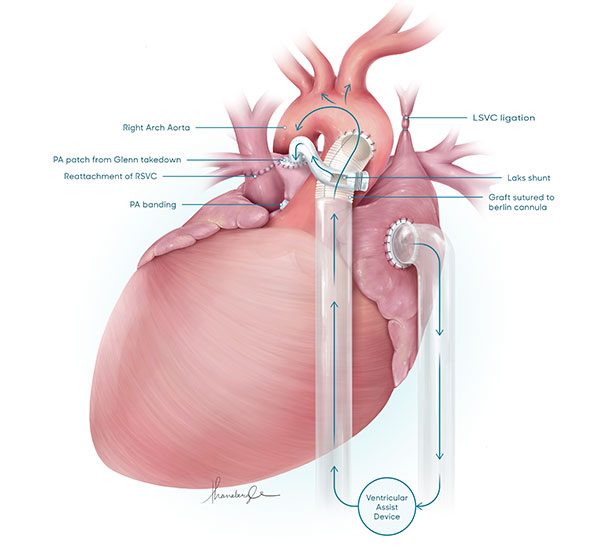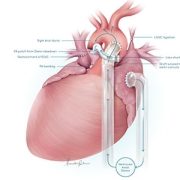Ventricular Assist Device (VAD) successfully used as bridge to congenital heart surgery

The team supported R’s heart using a VAD and an innovative implantation technique to increase the likelihood he would tolerate the device well.
A case study published in the Journal of Thoracic and Cardiovascular Surgery Techniques demonstrates a proof of concept that temporary use of a VAD to support a single ventricle heart may give that heart time to grow stronger and allow for corrective and lifesaving procedures under cardiopulmonary bypass instead of heart transplant.
What it means
The cardiac surgery team at Children’s National Hospital was able to offer a young boy’s family a lifesaving surgical option, after they were told elsewhere that their only choice was palliative care.
Baby R was born with a series of complex congenital heart conditions: Heterotaxy syndrome, unbalanced atrioventricular septal defect (AVSD), severe atrioventricular valve regurgitation, reduced ventricular function and obstructed total anomalous pulmonary venous drainage (TAPVD).
That combination of defects left his family facing an unthinkable statistic — there was an up to 90% possibility that R would die before reaching his first birthday.
A set of early interventions, including an initial attempt at a single ventricular correction called a bi-directional cavo-pulmonary shunt (BCPS) failed. His already weak heart was left even weaker than before. He continued to decline.
“We don’t ever want to say, ‘There is nothing we can do for your child,’” says Yves d’Udekem, M.D., Ph.D., chief of cardiac surgery at Children’s National. “Instead, we make the impossible, possible.”
The team decided to support R’s heart using a ventricular assist device (VAD) and an innovative technique during implantation of the VAD to increase the likelihood that he would tolerate the device well. By relieving some of the heart’s workload, they hoped that complicating functional issues might improve enough to allow surgeons to operate again and fix some of the structural conditions to optimize blood flow.
Children’s National leads the way
There is literature showing VAD used in this way in adults with heart failure, but until now it had never been successfully applied as a bridge to surgical intervention in a child with a single functioning ventricle. These assist devices are typically used only as a bridge to heart transplant in children.
This is the first documented case where ventricular assist device implantation resulted in gradual improvement in ventricular function, atrioventricular valve regurgitation, and pulmonary vascular resistance.
The improvements culminated in a major milestone: After 8 weeks of VAD support, at 6 months old, R was weaned off the device and had a successful BCPS, the first of several surgical procedures to make blood flow in his heart effective enough to sustain his organs.
When he was 14 months old, he returned for a successful second procedure along the established single ventricle pathway.
What’s next
R is nearly 3 years old and thriving at home, not in the CICU, as he waits to undergo the Fontan procedure — the final structural surgery for his single ventricle heart.
The knowledge and skill of Children’s National Heart Center turned this formerly hopeless situation into a brighter prognosis by repurposing existing technology to save a life.
In their case study conclusion, the team writes, “The observed improvement in ventricular function and AV valve regurgitation following VAD implantation in this patient is proof of the concept that patients with a failing single-ventricle circulation can be bridged to recovery by temporary VAD support. This concept may open new avenues of treatment.”
Read the study: Revalidation to single ventricle pathway with single ventricular assist device: Proof of concept











